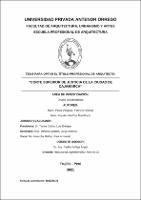Mostrar el registro sencillo del ítem
Corte superior de justicia de la ciudad de Cajamarca
| dc.contributor.advisor | Padilla Zúñiga, Ángel | |
| dc.contributor.author | Pérez Vásquez, Fabrizio Ernesto | |
| dc.contributor.author | Rossiter Mariños, Roni Paolo | |
| dc.creator | Pérez Vásquez, Fabrizio Ernesto | |
| dc.date.accessioned | 2021-08-18T23:42:29Z | |
| dc.date.available | 2021-08-18T23:42:29Z | |
| dc.date.issued | 2021 | |
| dc.identifier.uri | https://hdl.handle.net/20.500.12759/7913 | |
| dc.description.abstract | El Poder Judicial es uno de los tres poderes autónomos del estado peruano. Este se divide en diferentes niveles jerárquicos, siendo las Cortes Superiores de Justicia el segundo nivel de mayor jerarquía, estas se encuentran ubicadas en la capital del distrito judicial correspondiente, el caso de la presente investigación corresponde a la Corte Superior de Justicia del distrito judicial de Cajamarca ubicado en la ciudad del mismo nombre. A lo largo de los años la ciudad de Cajamarca ha sufrido un crecimiento urbano exponencial, debido a este desarrollo urbano las actividades político administrativas quedaron centralizadas alrededor de la plaza de armas, por lo que se decidió reubicarlas, y centralizarlas dentro del complejo Gran Qhapac Ñam. Debido a este crecimiento exponencial la demanda de casos de la Corte Superior de Justicia de Cajamarca aumentó, ya que no lograban satisfacer esta demanda en el año 2005 se empezó a alquilar locales para poder establecer en estos, los distintos juzgados que la ciudad necesitaba. En la actualidad la Corte Superior de Justicia de Cajamarca cuenta con 6 locales, siendo 5 de estos alquilados. Debido a que los locales alquilados no fueron diseñados bajo el concepto de arquitectura judicial se han generado distintos problemas en el correcto funcionamiento de esta institución, como el no tener circulaciones diferenciadas para los distintos tipos de usuarios que posee, una deficiente atención al público y un gasto innecesario de fondos. Es por esto que se plantea la propuesta de un proyecto factible que cumpla las necesidades para esta tipología de edificio, teniendo en cuenta una correcta diferenciación de circulaciones entre usuarios, generar espacios públicos que permitan integrarse al contexto urbano y sobre todo poseer una infraestructura que permita la implementación del nuevo código procesal | es_PE |
| dc.description.abstract | The Judicial Power is one of the three autonomous powers of the Peruvian state. This is divided into different hierarchical levels, being the Superior Courts of Justice the second highest level, these are located in the capital of the corresponding judicial district, the case of the present investigation corresponding to the Superior Court of Justice of the judicial district of Cajamarca located in the city of the same name. Over the years the city of Cajamarca has suffered exponential urban growth, due to this urban development the administrative political activities were centralized around the main square, so it was decided to relocate them, and centralize them within the Gran Qhapac Ñam complex. Due to this exponential growth, the demand for cases of the Superior Court of Justice of Cajamarca increased, since they could not satisfy this demand in 2005 they began to rent premises to be able to establish in these the different courts that the city needs. Currently, the Superior Court of Justice of Cajamarca has 6 premises, 5 of which are rented. Due to the fact that the rented premises were not designed under the concept of judicial architecture, different problems have been generated in the correct operation of this institution, such as not having differentiated circulations for the different types of users it has, poor attention to the public and a unnecessary spending of funds. This is why the proposal of a feasible project is proposed that meets the needs for this type of building, taking into account a correct differentiation of circulations between users, generating public spaces that are integrated into the urban context and above all having an infrastructure that allows the implementation of the new procedural code. | en_US |
| dc.description.uri | Tesis | es_PE |
| dc.format | application/pdf | es_PE |
| dc.language.iso | spa | es_PE |
| dc.publisher | Universidad Privada Antenor Orrego | es_PE |
| dc.relation.ispartofseries | MEM_ARQ_619 | |
| dc.rights | info:eu-repo/semantics/closedAccess | es_PE |
| dc.rights.uri | https://creativecommons.org/licenses/by/4.0/ | es_PE |
| dc.source | Universidad Privada Antenor Orrego | es_PE |
| dc.source | Repositorio Institucional - UPAO | es_PE |
| dc.subject | Centralización de Actividades | es_PE |
| dc.subject | Corte Superior de Justicia | es_PE |
| dc.title | Corte superior de justicia de la ciudad de Cajamarca | es_PE |
| dc.type | info:eu-repo/semantics/bachelorThesis | es_PE |
| thesis.degree.level | Titulo Profesional | es_PE |
| thesis.degree.grantor | Universidad Privada Antenor Orrego. Facultad de Arquitectura Urbanismo y Artes | es_PE |
| thesis.degree.name | Arquitecto | es_PE |
| thesis.degree.discipline | Arquitectura | es_PE |
| dc.subject.ocde | https://purl.org/pe-repo/ocde/ford#6.04.08 | es_PE |
| renati.advisor.orcid | https://orcid.org/0000-0002-7624-4103 | es_PE |
| renati.author.dni | 77563934 | |
| renati.author.dni | 70372705 | |
| renati.advisor.dni | 41118887 | |
| renati.type | https://purl.org/pe-repo/renati/type#tesis | es_PE |
| renati.level | https://purl.org/pe-repo/renati/level#tituloProfesional | es_PE |
| renati.discipline | 731176 | es_PE |
| renati.juror | Tarma Carlos, Luis Enrique | |
| renati.juror | Miñano Landers, Jorge Antonio | |
| renati.juror | Huaccha Muñoz, Raúl Armando | |
| dc.publisher.country | PE | es_PE |
Ficheros en el ítem
Este ítem aparece en la(s) siguiente(s) colección(es)
-
Arquitectura [446]


